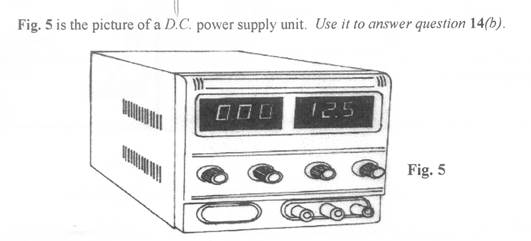Question 14

- (i) Identify Fig. 4.
- State the purpose of Fig.4.
- List three contents of Fig. 4.
- State the class of equipment to which Fig. 4 belongs.

- (i) State two uses of Fig. 5 in a mobile phone workshop.
- State two precautions taken when using Fig. 5

- (i) Identify Figs. 6 and 7.
- State two functions of
- Fig. 6;
- Fig. 7.
- State one advantage of
- Fig. 6 over Fig. 7
- Fig. 7 over Fig. 6
Most candidates attempted this question and the performance was good. This is due to increased awareness of the subject, engagement of qualified personnel to teach the subject and more exposure of candidates to practical work.
Observation
(a) (i) Fig.4: First Aid Box
(a)(ii) It contains materials needed for prompt treatment of injuries sustained in the workshop pending extensive medical attention if required.
(a)(iii) Contents of Fig.4
- Cotton wool
- Scissors
- Bandage
- Disposable gloves
- Hydrogen peroxide
- Adhesive plaster
- Tweezers
- Iodine solution
- Safety pins
- List of emergency phone numbers
- Methylated Spirit
- Pain relief drugs
- Antiseptic cream
- Thermometer
- Cleansing wipes
- Sticky tape
- Distilled water
- Syringe
- Needle
(a)(iv) Fig. 4 is a safety equipment
(b)(i) Uses of Fig. 5
It is used to
- Power on a mobile phone
- Boost / revive drained / discharged / flat battery
- Determine bridging status of phone PCB circuitry
- Know the voltage status of a mobile phone battery
- Supply power (as an alternative to battery) while repairing a phone
- Determine the battery polarity
- Trace the power supply line on the phone PCB
(b)(ii) Precautions taken when using Fig. 5
- Always keep the appropriate / required voltage constant before the phone is connected
- Always disconnect / switch off when not in use
- Do not short circuit the probes to avoid damage of the device
- Disconnect the phone or PCB before changing the voltage range to avoid damage
- Ensure correctness of the polarity of the device while connecting to the phone / PCB
(c)(i)
Fig. 6: UPS (Uninterrupted / Uninterruptible Power Supply)
Fig. 7: Stabilizer /Automatic Voltage regulator
(c)(ii) (I) Functions of Fig. 6
It
- provides emergency / backup power to a load when there is outage / failure from the main power source
- protects connected devices from power surge
- maintains a continuous supply of electric power to connected devices
(c)(ii)(II)Functions of Fig.7
It
- maintains steady output voltage in a circuit;
- prevents damage to connected equipment from power surge
(c)(iii)(I) Advantages of Fig.6 over Fig. 7
- UPS has batteries for storing electrical power which can be used when there is power outage
- UPS prevents data loss, injuries and disruptions that could arise from sudden power failure.
(c)(iii)(II) Advantage of Fig.7 over Fig. 6
- Stabilizer / Automatic Voltage Regulator helps to prevent damage to components by maintaining, supplying steady and required voltage to devices.
